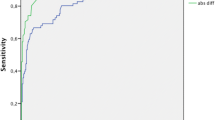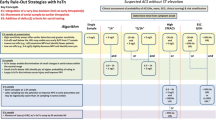Abstract
Objective
The study sought to compare the clinical performance of two more sensitive cardiac troponin (cTn) assays, a novel high-sensitivity (hs) troponin T assay and a contemporary cTnI assay.
Methods
We measured hs-cTnT (Roche TnThs) and cTnI (Siemens Centaur Ultra) on presentation in 1,384 patients with suspected acute coronary syndrome (ACS) who underwent early invasive strategy within 24 h after presentation. Kaplan–Meier, Cox proportional hazards, and receiver-operating characteristic (ROC) analysis was used to compare their prognostic performance for the prediction of all-cause death and death/MI (myocardial infarction) after a median of 271 days. We also compared the diagnostic performance of these assays on presentation for early diagnosis of non-STEMI.
Results
Both hs-cTnT and cTnI were independently predictive of long-term death (OR 3.51 vs. 2.19) and the composite of death/MI (OR 9.24 vs. 3.61), across the spectrum of ACS and in patients without ACS. When used as a continuous variable, ROC analysis demonstrated significantly higher areas under the curve (AUC) for hs-cTnT as compared to cTnI for the prediction of death/MI (0.721 vs. 0.672, P = 0.024), a trend to better prediction of all-cause death (0.721 vs. 0.672, P = 0.093) and significantly higher AUC for early diagnosis of non-STEMI (0.965 vs. 0.901, P < 0.001).
Conclusion
Using the 99th percentile cutoff for hs-cTnT and cTnI, both assays enable prediction of adverse long-term outcomes and earlier diagnosis of non-STEMI. Used as a continuous variable, the hs-cTnT assay showed superior performance compared to the cTnI assay, especially in regard to prognosis.


Similar content being viewed by others
References
Thygesen K, Alpert JS, White HD et al (2007) Universal definition of myocardial infarction. Circulation 116:2634–2653
Apple FS, Smith SW, Pearce LA et al (2008) Use of the Centaur TnI-Ultra assay for detection of myocardial infarction and adverse events in patients presenting with symptoms suggestive of acute coronary syndrome. Clin Chem 54:723–728
Venge P, James S, Jansson L et al (2009) Clinical performance of two highly sensitive cardiac troponin I assays. Clin Chem 55:109–116
Keller T, Zeller T, Peetz D et al (2009) Sensitive troponin I assay in early diagnosis of acute myocardial infarction. N Engl J Med 361:868–877
Reichlin T, Hochholzer W, Bassetti S et al (2009) Early diagnosis of myocardial infarction with sensitive cardiac troponin assays. N Engl J Med 361:858–867
Apple FS (2009) A new season for cardiac troponin assays: it’s time to keep a scorecard. Clin Chem 55:1303–1306
Prontera C, Fortunato A, Storti S et al (2007) Evaluation of analytical performance of the Siemens ADVIA TnI ultra immunoassay. Clin Chem 53:1722–1723
Giannitsis E, Kurz K, Hallermayer K et al (2010) Analytical validation of a high-sensitivity cardiac troponin T assay. Clin Chem 56:254–261
Giannitsis E, Katus HA (2009) Troponins and high-sensitivity troponins as markers of necrosis in CAD and heart failure. Herz 34:600–606
Celik S, Giannitsis E, Wollert KC et al (2011) Cardiac troponin T concentrations above the 99th percentile value as measured by a new high-sensitivity assay predict long-term prognosis in patients with acute coronary syndromes undergoing routine early invasive strategy. Clin Res Cardiol 100:1077–1085
James S, Armstrong P, Califf R et al (2003) Troponin T levels and risk of 30-day outcomes in patients with the acute coronary syndrome: prospective verification in the GUSTO-IV trial. Am J Med 115:178–184
Eggers KM, Jaffe AS, Lind L et al (2009) Value of cardiac troponin I cutoff concentrations below the 99th percentile for clinical decision-making. Clin Chem 55:85–92
Lindahl B, Diderholm E, Lagerqvist B et al (2001) Mechanisms behind the prognostic value of troponin T in unstable coronary artery disease: a FRISC II substudy. J Am Coll Cardiol 38:979–986
Morrow DA, Rifai N, Sabatine MS et al (2003) Evaluation of the AccuTnI cardiac troponin I assay for risk assessment in acute coronary syndromes. Clin Chem 49:1396–1398
Venge P, Lagerqvist B, Diderholm E et al (2002) Clinical performance of three cardiac troponin assays in patients with unstable coronary artery disease (a FRISC II substudy). Am J Cardiol 89:1035–1041
Kontos MC, Shah R, Fritz LM et al (2004) Implication of different cardiac troponin I levels for clinical outcomes and prognosis of acute chest pain patients. J Am Coll Cardiol 43:958–965
Morrow DA, Cannon CP, Rifai N et al (2001) Ability of minor elevations of troponins I and T to predict benefit from an early invasive strategy in patients with unstable angina and non-ST elevation myocardial infarction: results from a randomized trial. JAMA 286:2405–2412
Kastrati A, Mehilli J, Neumann FJ et al (2006) Abciximab in patients with acute coronary syndromes undergoing percutaneous coronary intervention after clopidogrel pretreatment: the ISAR-REACT 2 randomized trial. JAMA 295:1531–1538
Venge P, Johnston N, Lindahl B et al (2009) Normal plasma levels of cardiac troponin I measured by the high-sensitivity cardiac troponin I access prototype assay and the impact on the diagnosis of myocardial ischemia. J Am Coll Cardiol 54:1165–1172
Kavsak PA, Wang X, Ko DT et al (2009) Short- and long-term risk stratification using a next-generation, high-sensitivity research cardiac troponin I (hs-cTnI) assay in an emergency department chest pain population. Clin Chem 55:1809–1815
Melanson SE, Morrow DA, Jarolim P (2007) Earlier detection of myocardial injury in a preliminary evaluation using a new troponin I assay with improved sensitivity. Am J Clin Pathol 128:282–286
Giannitsis E, Becker M, Kurz K et al (2010) High-sensitivity cardiac troponin T for early prediction of evolving non-ST-segment elevation myocardial infarction in patients with suspected acute coronary syndrome and negative troponin results on admission. Clin Chem 56:642–650
Mueller M, Biener M, Vafaie M et al (2012) Absolute and relative kinetic changes of high-sensitivity cardiac troponin T in acute coronary syndrome and in patients with increased troponin in the absence of acute coronary syndrome. Clin Chem 58:209–218
Acknowledgments
The investigations were supported by Roche Diagnostics, Germany providing hs-TnT assays.
Conflict of interest
EG has received financial support for clinical trials from Roche Diagnostics, Germany. He is consultant to Roche Diagnostics and receives honoraria for lectures from Roche Diagnostics. JLJ has received grant support from Roche Diagnostics, and has received honoraria for lectures from Roche Diagnostics. HAK has developed the cTnT assay and holds a patent jointly with Roche Diagnostics. He has received grants and research support from several companies, and has received honoraria for lectures from Roche Diagnostics.
Author information
Authors and Affiliations
Corresponding author
Electronic supplementary material
Below is the link to the electronic supplementary material.
Rights and permissions
About this article
Cite this article
Mueller, M., Celik, S., Biener, M. et al. Diagnostic and prognostic performance of a novel high-sensitivity cardiac troponin T assay compared to a contemporary sensitive cardiac troponin I assay in patients with acute coronary syndrome. Clin Res Cardiol 101, 837–845 (2012). https://doi.org/10.1007/s00392-012-0469-6
Received:
Accepted:
Published:
Issue Date:
DOI: https://doi.org/10.1007/s00392-012-0469-6




